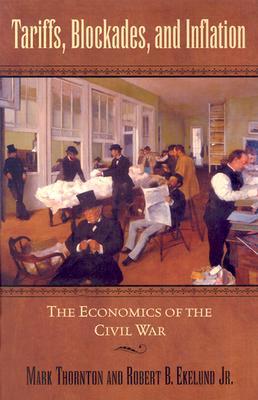A calm image of businessmen and clerks engaged in the buying and selling of cotton on the New Orleans Cotton Exchange is not what you expect to find on the dust jackets of books about the Civil War. The Edgar Degas painting that graces the cover of Tariffs, Blockades, and Inflation, however, tells the reader that this is no ordinary book on the War Between the States. One searches its pages in vain for depictions of battle scenes, accounts of heroic acts, or descriptions of weapons and uniforms. Instead, there are clear explanations of how economic issues were driving forces behind the causes of the Civil War.
Mark Thornton and Robert Ekelund have collaborated on many articles on the Civil War that have appeared in a variety of publications. Both are economists who write extensively in their field. The authors believe that the War Between the States drastically altered “the very substance and concept of the American nation.” They see it as a sectional conflict with a number of related parallels: the Jeffersonian tradition versus the Hamiltonian one, agrarianism versus industrialism, states’ rights versus governmental centralism. These dichotomies are all explored in their book, together with the misguided economic policies adopted by both sides, to their detriment.
The authors’ discussion of the tariff question is actually a study of the cultural differences between the North and the South. Thornton and Ekelund argue that the most important aspect of the war took place at sea, between the blockade runners and the blockading fleet. The blockade resulted not only in reduced production and trade but in hoarding and speculation. How the Confederacy as well as the Union used inflation to finance the conflict and disguise its costs is described, along with the monetary legacy of the war. The authors trace inflation and financial panics to the federal government’s intervention in the banking industry, which, up until that time, had been primarily a matter for state regulation, and demonstrate that L. Frank Baum’s The Wonderful Wizard of Oz may be read as an allegorical treatment of the monetary concerns expressed by the Populists in the late 19th century.
Thornton and Ekelund explode the myth that the scourge of war can actually benefit an economy as a whole. Like the War Between the States itself, the postwar period we call Reconstruction, they note, is “rarely [described] from the perspective of economic theory.” The authors argue that technological improvements, the intercontinental railroad, large-scale heavy industry, and the basic national-science institutions began before the war, not as a result of it. The Civil War retarded economic development; yet, owing to the overriding focus by historians on the abolition of slavery, it has been viewed as a national benefit rather than as a national disaster.
According to Ekelund and Thornton, the ideological origins of the war are found in the early 1800’s. Thus, rather than to the exploits of Lee and Grant (who receive no mention in the book), we are introduced to the politics and policies of John Adams, Thomas Jefferson, Alexander Hamilton, Andrew Jackson, Henry Clay, and John C. Calhoun. And, instead of confronting the traditional Democratic/Republican division, we read of the Democratic-Republicans, Federalists, Antifederalists, Free-Soilers, Whigs, and anti-immigration parties. The mercantilist economic agenda of the nascent Republican Party that was anathema to the agrarian South, and its philosophical connection with Hamilton and Clay, receive special attention in this book. The election of Lincoln in many ways ended the limited government envisioned by the Framers. Thornton and Ekelund compare the “flurry of new laws, regulations, and bureaucracies” created by the Lincoln administration to that of Franklin Roosevelt’s New Deal in the 1930’s; indeed, they point out that the term New Deal was coined by a newspaper editor in 1865 to describe the rule of Lincoln and the Republicans.
Although small in size, Tariffs, Blockades, and Inflation is an extremely penetrating work that broadens our understanding of the great sectional conflict we call the Civil War—a war that not only changed forever the cultural fabric of the United States but inexorably altered the government established by the Framers.
[Tariffs, Blockades, and Inflation: The Economics of the Civil War, by Mark Thornton and Robert B. Ekelund (Wilmington, DE: Scholarly Resources) 124 pp., $65.00]

Leave a Reply